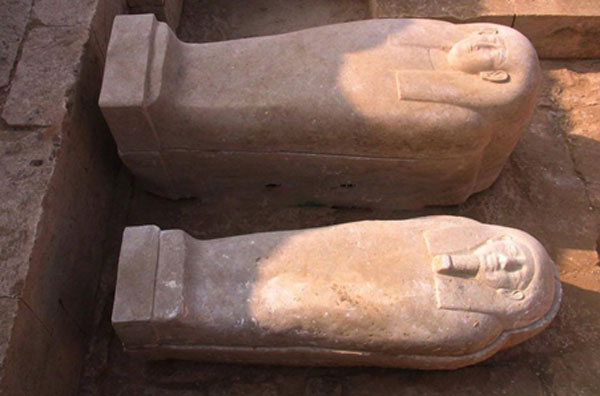Two 26th dynasty tombs unearthed in Egypt containing mummies and fascinating grave goods
Two ancient Egyptian tombs have been discovered by a Spanish – Egyptian team at the Al-Bahnasa archaeological site located in Minya, Egypt, according to a new report in Ahram Online. The ancient tombs, which date back around 2,500 years, contain sarcophagi with the mummified remains of a scribe and a priest, along with an intriguing array of funerary items.
The tombs belong to the 26 th Dynasty of Egypt (c. 685–525 BC), the last native dynasty to rule Egypt before the Persian conquest in 525 BC (although others followed). The Dynasty's reign is also called the Saite Period after the city of Sais, where its pharaohs had their capital, and marks the beginning of the Late Period of ancient Egypt. The large number of coins dating back to this Dynasty reveals that the Saiiti era was one of Egypt’s flourishing periods.
According to a statement issued by the Minister of Antiquities, Mohamed Ibrahim, the first tomb belongs to a prominent ancient writer, who would have had a "great impact on the intellectual and cultural life of the era." Scribes played an important role in Egyptian society and were central to the functioning of centralised administration, the army, and the priesthood. Scribes were part of only a small percentage of ancient Egyptian society who could read and write. The hieroglyphic language of the ancient Egyptians was complex and beautiful and those who had mastered it held a valued position in society and thus became members of the royal court.

26th Dynasty tomb uncovered. Photo source.
Inside the scribe’s tomb, archaeologists uncovered the deceased mummy, which is in a good state of preservation, along with a bronze inkwell and two small bamboo pens, which would have been placed there to aid the writer in his work in the afterlife.
Unusually, the researchers also discovered mummified fish within the tomb, which is the “first time to find stuffed or mummified fish inside a tomb,” according to Ali El-Asfar, head of the Ancient Egyptian Antiquities Sector at the Ministry of Antiquities. Fish were mummified in mass quantities in ancient Egypt as offerings to the god. They were wrapped in linen and held together by bands of cloth soaked in sticky resin, permanently encasing the mummies. However, since these fish were found within the tomb of the deceased, it is believed they were placed there as food for the scribe in his afterlife.

An example of mummified fish found in ancient Egypt. Photo source.
The second tomb that was uncovered belongs to a priest who was the head of a family many of whose members were priests in the Osirion Temple. This temple was uncovered recently two kilometres west of the tomb. Inside the tomb, archaeologists found a large collection of stone sarcophagi, some of which were broken, along with canopic jars carved in alabaster and bearing hieroglyphic texts as well as a collection of 26 th Dynasty bronze coins and bronze Osirian statuettes.

Bronze Osirian statuettes found in the second tomb. Photo source.
Featured image: Sarcophagi found in the 26 th Dynasty tombs. Photo source.


















Comments
I know what you're saying and I agree with you 100%. However, they excavate these tombs due to a black market that deals with this type/kind of antiquity. Most mummies, and if possible, the coffin are now returned within the tomb .... and hopefully left in peace behind locked doors. As for other objects found in the tomb, that could be sold, those go to a museum to be conserved.
I honestly don't understand why people keep digging for graves!? I mean I understand a chance discovery, like when building something else, but to specifically dig the dead out is repulsive. Isn't the reason we bury the dead so they stay underground in peace?! If somebody died a few decades ago their grave is sacred and cannot be touched but if you died a few thousand years ago you are just an *artifact* not a dead body to be treated with respect.